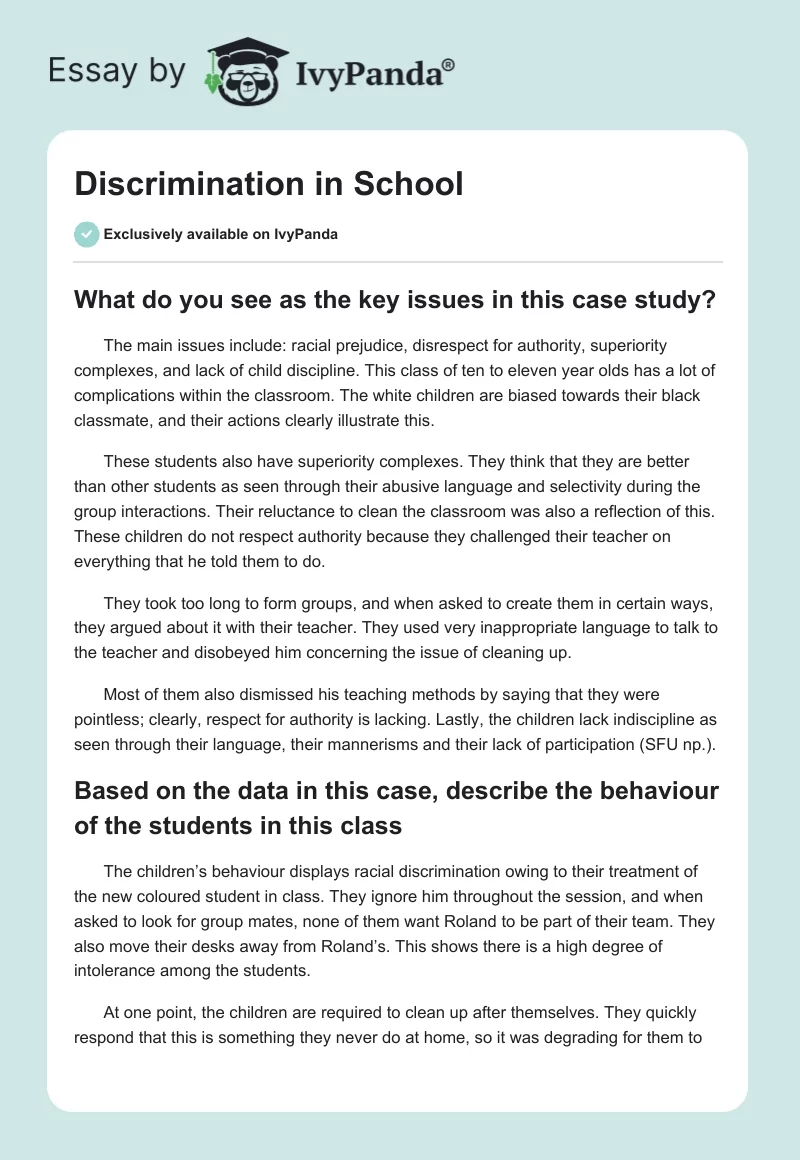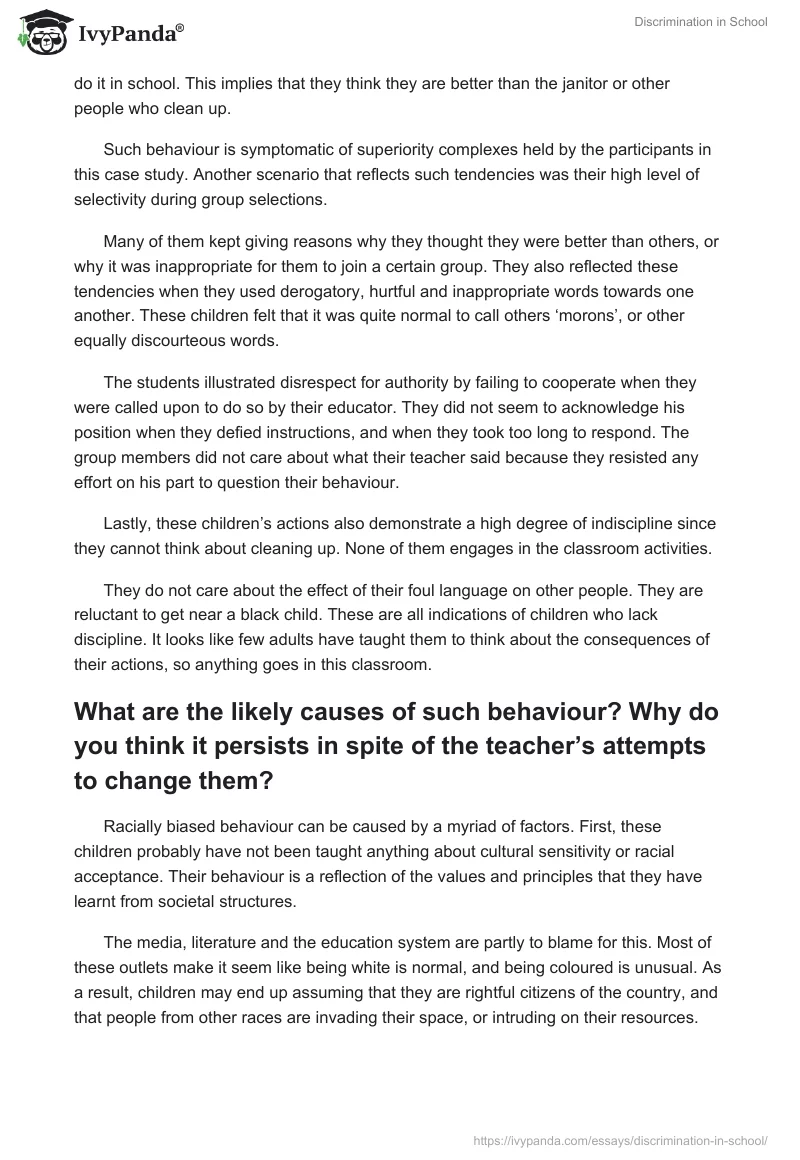The key issues in the case study
The main issues include: racial prejudice, disrespect for authority, superiority complexes, and lack of child discipline. This class of ten to eleven-year-olds has a lot of complications within the classroom. The white children are biased towards their black classmate, and their actions clearly illustrate this.
These students also have superiority complexes. They think that they are better than other students as seen through their abusive language and selectivity during the group interactions. Their reluctance to clean the classroom was also a reflection of this. These children do not respect authority because they challenged their teacher on everything that he told them to do.
They took too long to form groups, and when asked to create them in certain ways, they argued about it with their teacher. They used very inappropriate language to talk to the teacher and disobeyed him concerning the issue of cleaning up.
Most of them also dismissed his teaching methods by saying that they were pointless; clearly, respect for authority is lacking. Lastly, the children lack indiscipline as seen through their language, their mannerisms and their lack of participation (SFU np.).
Describing the behaviour of the students in the class
The children’s behaviour displays racial discrimination owing to their treatment of the new coloured student in class. They ignore him throughout the session, and when asked to look for group mates, none of them want Roland to be part of their team. They also move their desks away from Roland’s. This shows there is a high degree of intolerance among the students.
At one point, the children are required to clean up after themselves. They quickly respond that this is something they never do at home, so it was degrading for them to do it in school. This implies that they think they are better than the janitor or other people who clean up.
Such behaviour is symptomatic of superiority complexes held by the participants in this case study. Another scenario that reflects such tendencies was their high level of selectivity during group selections.
Many of them kept giving reasons why they thought they were better than others, or why it was inappropriate for them to join a certain group. They also reflected these tendencies when they used derogatory, hurtful and inappropriate words towards one another. These children felt that it was quite normal to call others ‘morons’, or other equally discourteous words.
The students illustrated disrespect for authority by failing to cooperate when they were called upon to do so by their educator. They did not seem to acknowledge his position when they defied instructions, and when they took too long to respond. The group members did not care about what their teacher said because they resisted any effort on his part to question their behaviour.
Lastly, these children’s actions also demonstrate a high degree of indiscipline since they cannot think about cleaning up. None of them engages in the classroom activities.
They do not care about the effect of their foul language on other people. They are reluctant to get near a black child. These are all indications of children who lack discipline. It looks like few adults have taught them to think about the consequences of their actions, so anything goes in this classroom.
The likely causes of such behaviour and why it persists
Racially biased behaviour can be caused by a myriad of factors. First, these children probably have not been taught anything about cultural sensitivity or racial acceptance. Their behaviour is a reflection of the values and principles that they have learnt from societal structures.
The media, literature and the education system are partly to blame for this. Most of these outlets make it seem like being white is normal, and being coloured is unusual. As a result, children may end up assuming that they are rightful citizens of the country, and that people from other races are invading their space, or intruding on their resources.
In many western societies, adults tend to value individual rather than collective responsibility for actions. Therefore, historical matters are rarely taken seriously by members of the white race. In a study carried out by Lewis-Charp (281), it was found that most white participants dismissed the historical experiences of people of colour.
They affirmed that everyone was responsible for his or her fate, and even blamed black people for their negative social positions. By spreading such values, it is possible for white children to become insensitive to the plight of coloured peers.
If the children in this case study empathised with members of other races, then they would have treated Roland in a respectful manner. Parental failures may also have led to the lack of respect for authority. Their caregivers probably had not taught the children about the importance of respecting older people. They may have let things spiral out of control by failing to punish their children for wrong behaviour.
This behaviour could also have been copied from their parents or other adults that they interact with in their daily experiences. Some parents may blatantly act racist in front of their children, and this may send the message that acting that way is acceptable.
Alternatively, some parents may shun opportunities to talk about race with their children. They may sweep matters under the carpet in the hope that avoiding these confrontations will prevent their children from hurting other people (Polite and Saenger 277).
Essentially, such children may rely on other less accurate sources for information on racial matters. Their parents may also be using disrespectful language towards one another, and their children may have picked up the habit from them.
The curriculum and the general school system are also partly to blame for this. Many students know very little about other racial groups simply because formal school programs do not provide forums to discuss and learn about racial issues. The school system does not allow teachers and students to know about class privilege and skin colour.
How teachers can lessen the prejudice in the classroom
Teachers need to confront these prejudices directly. They need to find out the root cause of racist behaviour and then challenge the assumptions that cause them. They could talk about the notions of fairness and equality, and how this contradicts the treatment of others discriminatively (Lewis-Charp 284).
They can work together with school administrators in order to introduce multicultural curricula in their classrooms. They need to address their own biases as these may rub off on the students. They need to refrain from indirectly referring to white people in literature as ‘us’ and coloured people as ‘them’.
Teachers should also ensure that they identify and teach students about coloured people who have succeeded in various capacities so as to challenge those negative stereotypes.
These suggestions can work because they first get to the root of the problem, are integrative, and allow teachers to serve as role models to their students. Furthermore, they are based on sound principles of multicultural democracy.
Works Cited
Lewis-Charp, Heather. “Breaking the silence: white students’ perspectives on race in multiracial schools.” Phi Delta Kappan (2003): 279-285. Print.
Polite, Lillian & Saenger, Baird. “A pernicious silence: Confronting race in the elementary classroom.” Phi Delta Kappan (2003): 274-278. Print.
SFU. Case study 5. Simon Fraser University, 2011. Web.


